Katrina Kenison's Blog, page 10
May 22, 2014
Daring, dreaming, doing — words to guide & inspire
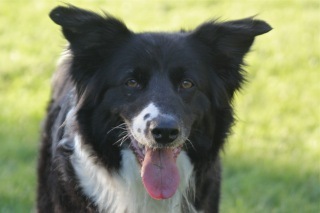 I do have a dog story to tell here, but that will have to wait until I can do justice to Tess, the newest member of our family, a sweet border collie rescue girl who’s as happy to have a home as we are to give her one. At the moment, there isn’t much time for writing. We’re all pretty consumed with getting to know each other, mastering the basics on both sides. There are hikes to take, new lessons to learn, trust to earn, routines to work out. More on Tess soon.
I do have a dog story to tell here, but that will have to wait until I can do justice to Tess, the newest member of our family, a sweet border collie rescue girl who’s as happy to have a home as we are to give her one. At the moment, there isn’t much time for writing. We’re all pretty consumed with getting to know each other, mastering the basics on both sides. There are hikes to take, new lessons to learn, trust to earn, routines to work out. More on Tess soon.
Meanwhile, both our sons have been home this month, all of us here together for the first time since Christmas. Over the next week, Jack will return to Atlanta and Henry will leave for his summer job directing musicals at a theatre in the Catskills. For now, though, I’m grateful for every family dinner, walks and talks, the fullness of our days, the peace of nights when everyone I love is safely gathered under one roof. Soon, the house will be quieter, the refrigerator easier to keep filled, my days at home my own again. Plenty of time then for reflections and blog posts.
Still, I can’t resist sharing a few of the things we’ve been watching and reading and discussing around here, while hanging out in the kitchen and in between basketball playoff games and Red Sox losses.
Being in one’s early twenties isn’t easy – not quite launched into full-scale independent adulthood but no longer an adolescent; so much to figure out and no road map to point the way forward; so many choices while already a few doors are closing for good, the “right” path rarely if ever easy to discern.
Pursue a dream at all costs or take the first job that offers a modicum of security? What’s the real definition of success? What constitutes a good life? Is “good” synonymous with meaningful? How does anyone summon the vision to dream, the courage to dare, the will to do, especially when the doing isn’t part of the plan or involves some precipitous twists in the road? When, as a parent, should I speak up and when should I quietly reserve judgment and opinion? There are no ready answers to any of our questions. But as the graduation photos appear on Facebook, as our young adults celebrate and question and struggle and figure out their own next steps, these voices offer some varied perspectives on the big picture.
 Whether you’re 18 or 28 or 68, Elizabeth Gilbert’s brilliantly succinct new TED talk will point your way toward home, home being “whatever you love in this world more than you love yourself.” As Liz’s own experiences have taught her, both abject failure and extraordinary success can blow even an experienced traveler pretty far off course. Here, seven thoughtful minutes about how we can protect ourselves from the random hurricanes of outcome by never forgetting where we “rightfully live.”
Whether you’re 18 or 28 or 68, Elizabeth Gilbert’s brilliantly succinct new TED talk will point your way toward home, home being “whatever you love in this world more than you love yourself.” As Liz’s own experiences have taught her, both abject failure and extraordinary success can blow even an experienced traveler pretty far off course. Here, seven thoughtful minutes about how we can protect ourselves from the random hurricanes of outcome by never forgetting where we “rightfully live.”
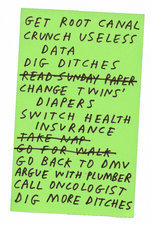 “Do what you love, the money will follow” — we’ve all heard that one and longed for it to be true. In the New York Times last Sunday, a philosophy professor from St. Olaf boldly asks: “Is do what you love wisdom or malarkey?” Read his provocative answer to that question here.
“Do what you love, the money will follow” — we’ve all heard that one and longed for it to be true. In the New York Times last Sunday, a philosophy professor from St. Olaf boldly asks: “Is do what you love wisdom or malarkey?” Read his provocative answer to that question here.
Leo Babuta’s wildly popular Zen Habits blog isn’t exactly about Zen, but it is very much about cultivating awareness in our everyday lives. With little fanfare, and writing from his own personal experience, Leo explores the beauty of simplicity and the joy of living with less in order to experience more. Recently, he received a letter from a 15-year-old reader asking for career advice. She wrote, “I’m young, and I don’t want to make a mistake and ruin my future.” In response, Leo composed a brief guide for young people entitled “What to Do With Your Life.” His advice, lightly offered but deeply wise, is as good a response as I’ve seen to the age-old question “How should I live?” Read it here.
 Late one night a few weeks ago, Jack showed me a link on Facebook. “It’s Nico,” he said, “my old friend from camp.” I have a vivid memory of Jack and Nico, age twelve or so, racing down a grassy hill after lunch on Parents’ Day at Camp Encore Coda, the two of them running off to play ping-pong. Rather, Jack was running. And Nico was hopping along beside him on one leg. According to Jack, Nico also happened to be the best ping-pong player at camp, more athletic on his one leg than most kids are on two. I don’t think I’ll say another word about this video, which is actually an ad for a sports drink, other than to say it’s not really about a drink. It’s about grace and courage and not ever giving up. It’s about that “home” Liz Gilbert describes so well — the place where we let go of outcomes and simply do what we do because of who we are born to be and what we are born to love. Click here to have your heart enlarged.
Late one night a few weeks ago, Jack showed me a link on Facebook. “It’s Nico,” he said, “my old friend from camp.” I have a vivid memory of Jack and Nico, age twelve or so, racing down a grassy hill after lunch on Parents’ Day at Camp Encore Coda, the two of them running off to play ping-pong. Rather, Jack was running. And Nico was hopping along beside him on one leg. According to Jack, Nico also happened to be the best ping-pong player at camp, more athletic on his one leg than most kids are on two. I don’t think I’ll say another word about this video, which is actually an ad for a sports drink, other than to say it’s not really about a drink. It’s about grace and courage and not ever giving up. It’s about that “home” Liz Gilbert describes so well — the place where we let go of outcomes and simply do what we do because of who we are born to be and what we are born to love. Click here to have your heart enlarged.
Our children grow up. They leave us. They create lives of their own, elsewhere. Except when they don’t, because they can’t. Karen Maezen Miller will never forget the boy in the blue bandana. Neither will I. Neither will you. Click here to have your heart tugged. Hard.
As my own sons head off to embark on their next chapters, the urge to offer some motherly advice is strong as ever. And yet I know there’s really nothing I can say that will make a difference. Part of the journey is finding your own way. Still, if I could slip just one message into their backpacks as they head out the door, it would be these simple words written by a now-obscure woman known as Peace Pilgrim, who spent 28 years, from 1953 till 1981, traversing our country on foot on a personal pilgrimage for peace – walking, as she said, not to get someplace but for an idea.
Live in the present. Do the things that need to be done. Do all the good you can each day. The future will unfold.
And finally, this. A friend who is not a parent sent me Mary Karr’s poem. Somehow he knew anyway what it must be like now for me, a mother of grown sons. I read it through tears of recognition, reminded once again that I’m not alone in these feelings after all, that we mothers share a bond deeper than language but sometimes, if only rarely, exquisitely captured by another’s words on the page.
Entering the Kingdom
As the boy’s bones lengthened,
and his head and heart enlarged,
his mother one day failed
to see herself in him.
He was a man then, radiating
the innate loneliness of men.
His expression was ever after
beyond her. When near sleep
his features eased towards childhood,
it was brief.
She could only squeeze
his broad shoulder. What could
she teach him
of loss, who now inflicted it
by entering the kingdom
of his own will?
– Mary Karr
The post Daring, dreaming, doing — words to guide & inspire appeared first on Katrina Kenison.
May 11, 2014
Happy Mother’s Day & a letter to my mom
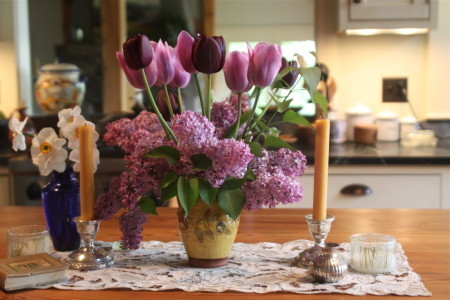 Every year, I tell my sons what I’d like for Mother’s Day: a letter. Something, anything, on paper, that I can keep close at hand for a while, re-read till I’ve memorized each line, and then tuck away in a drawer to save and read again. For me, words written from the heart are more precious than anything that could be bought from a store. I don’t always get my wish, nor do I always take the time to write to my own mother. (Yes, it really is so much easier to buy a card, choose some flowers, indulge in a nice dinner out.)
Every year, I tell my sons what I’d like for Mother’s Day: a letter. Something, anything, on paper, that I can keep close at hand for a while, re-read till I’ve memorized each line, and then tuck away in a drawer to save and read again. For me, words written from the heart are more precious than anything that could be bought from a store. I don’t always get my wish, nor do I always take the time to write to my own mother. (Yes, it really is so much easier to buy a card, choose some flowers, indulge in a nice dinner out.)
This year, Jack is at home and we’ll spend the entire day together. With Steve and Henry both on a trip, Jack offered to join me in my annual spring “cleanse” and we’ve been partners all week in this challenging endeavor, juicing and eating raw fruits and veggies and practicing yoga. His presence, and his willingness to try — wholeheartedly! — what he calls “the mom lifestyle” for a week has been a gift in itself. (In a few minutes, we’ll have our Mother’s Day breakfast together: a green smoothie with kale and sunflower seeds. And then we’ll head off to yoga class — my idea of a very happy Mother’s Day indeed.)
I used to mourn the end of my sons’ childhoods, especially on Mother’s Day, nostalgic for the years of breakfast in bed, Crayola cards, my sons’ eager assistance as we planted the flowers my husband had helped them pick out at the nursery. But I’ve finally made my peace with what is now long over. Last weekend we watched Henry’s first class of jazz students perform at a May Day celebration. It was a full-circle moment. Nine years ago, he was the fourteen-year-old freshman trying out his jazz chops at the dessert cafe on May Day, and now he’s returned to his old high school to teach jazz himself. My heart swelled, my eyes brimmed, just as they always did at every school event. “Now” may be the only time there is, but “now,” these days, comes with an even deeper appreciation for time passing, the moments layered with memories and associations and gratitude. As I grow older, “now” becomes ever richer, deeper, more precious.
Jack’s life in Atlanta, far from us, suits him. He comes home now as an adult visiting, not as a child returning. And so, knowing our time under this roof is brief, I sense a new willingness on both our parts to stretch toward one another, to find and inhabit the common ground, to accommodate each other’s idiosyncrasies with affection. At twenty-one and twenty-four, my sons “get” me very well indeed. And I think they know this, too – much as I will always love receiving a handwritten letter on Mother’s Day, the best gift they can possibly give me is their own health and happiness, the very fact of their busy, full, well-lived lives.
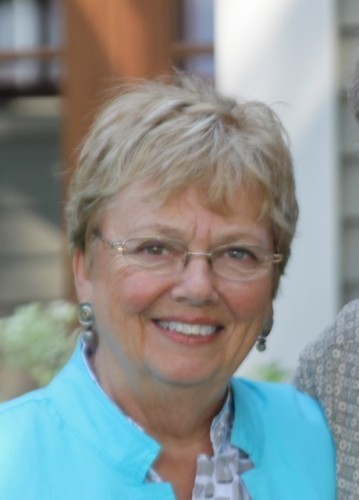 I wonder if my own mother feels the same, having watched her two children grow up and marry, become parents and raise families themselves? I suspect so. What she wants at 78 is not more “stuff,” she’s getting rid of things, not accumulating them. Nor does she have any desire to be the center of our lives. What she wants, surely what every mother wants, is more time to bear witness to her children’s continuous unfolding, to share in the ups and downs of our everyday thisses and thats.
I wonder if my own mother feels the same, having watched her two children grow up and marry, become parents and raise families themselves? I suspect so. What she wants at 78 is not more “stuff,” she’s getting rid of things, not accumulating them. Nor does she have any desire to be the center of our lives. What she wants, surely what every mother wants, is more time to bear witness to her children’s continuous unfolding, to share in the ups and downs of our everyday thisses and thats.
I don’t often pause to think about it, and yet my mom is the one person who has been right here, at my side and on my side, from the moment I drew my very first breath. How to ever fully appreciate the woman whose presence and love and example have shaped me into the adult I am? How to capture even a small part of the sharing, sacrificing, and support she has given me over the years? Of course, she’d probably appreciate a letter herself.
Dear Mom,
I can’t possibly do you justice in a letter, or give voice to all the memories, but here are just a few that come to mind as I think back:
I remember the bracelet, dark red and blue shoe-buttons strung on elastic, that I made for you in kindergarten when I was five, the first Mother’s Day gift fashioned by my hand. I remember seeing it for years, tucked in the corner of the jewelry box on your dresser where you kept it, loved and treasured if not worn.
I remember soft pajamas with feet and Sunday night suppers served on TV trays in the living room. You gave us Welsh rabbit on Saltines, milk in gray plastic mugs with brightly colored rims, The Wonderful World of Disney, and a bedtime that was the same every night. I remember lullabies and “Mairzie Doates,” and “Tell Me Why the Stars Do Shine” and the comfort of knowing, because you told me again and again, that I was good and well-loved and would always be taken care of.
I remember the first deliberate lie I tried to get away with – “the cat did it” – and how you somehow saw right through my five-year-old fabrication and gave me time to figure out for myself that the truth would be better.
I remember that I could not, would not, put my face under water at the Air Force pool. I remember that, to my huge relief, you didn’t make me do it. And I also remember two small Dutch dolls, a girl and a boy, with wooden shoes and painted faces. I remember you giving them to me on a hot summer day for no reason at all, except, perhaps, because that was the afternoon when I finally coaxed my terrified self all the way into that pool.
I remember peeking through the keyhole of your bedroom door late at night, hoping for a black and white glimpse of Danny Kaye on TV, and hoping I wouldn’t get in too much trouble if you found me crouching there. I remember you taking me by the hand and leading me back to bed and tucking me in with a kiss.
I remember the only good part about being sick: your cool hand on my forehead as I knelt in front of the toilet bowl, retching up dinner. The comfort of being held. A cool washcloth. Clean sheets, a night breeze through the window, peace.
I remember a bedroom done over, just for me,
I remember a bright pink corduroy jumper that you sewed on the green Singer, and a shirt with daisies growing up the front, and playing dress up in your filmy blue nightgown and pearls, tottering down the driveway in your shoes, feeling like a princess in your grown-up things.
I remember Easter baskets and Easter dresses and your hand on my knee in church. The ting-a-ling on Christmas Eve, the tiny bronze angels pinging against the hot chimes as you read the story of Jesus’s birth from the book of Matthew. I remember watching you stuff turkey after turkey after turkey, a lifetime’s worth of turkeys roasted and holiday meals served and cleaned up after. I remember the kitchen table set with plates and silverware and folded napkins, every single night of our lives.
I remember finding your most precious books in a chest in Grammie Stanchfield’s attic, studying your careful, girlish penmanship, absorbing the shock of your maiden name inscribed all those years ago on the faded inside cover of “Black Beauty.” I remember being stunned by the realization of your childhood, the fact that you had once been a little girl yourself, and that you had had a whole, complete life before me.
I remember summer evenings, you reading out loud as we sprawled on John’s bed, scratching at mosquito bites and patches of poison ivy. The Family Finds Out, The Borrowers, Misty of Chincoteague. I remember wishing the books would never end, that you wouldn’t turn out the light, that the day didn’t have to be over so soon.
I remember that you always called your mother on the day of the first snowfall of winter. I remember the day you lost her.
I remember when you allowed me to buy “Magical Mystery Tour” and bring my phonograph outside on the back deck and play The Beatles really loud. I remember being in the back seat of our red Plymouth Fury as you drove along, eyes on the road, and explained to me about sex. And I remember being disappointed that it sounded so weird and unfun. I remember, cringing a bit even now, the first bra you bought me and how embarrassed I was — by the color (red!!), the name (“Little Me”), the prospect of wearing it, the very possibility of breasts.
I remember countless long walks in the woods and one picnic lunch on the stoop of an abandoned house, and an early morning breakfast we carried up into the low, embracing branches of a special tree. I remember admitting to my best friend at school that you were my best friend.
I remember how good you looked on a horse. Back tall and straight, hands quiet, heels down. I remember how nervous you were about riding and that you did it anyway. I remember the day you flew a plane by yourself — and I remember thinking, “I will never do that.”
I remember confiding in you ahead of time that I was going to sleep with my boyfriend, and then realizing that you might have preferred not to know. I remember wanting to tell you all about it the next day and forcing myself, for your sake, to keep quiet.
I remember going out to lunch, just you and me, the day before I left for college, at a long-gone place called The Avocado, and ordering a drink, and feeling sadness and excitement all mixed up together, already missing you on the one hand and, on the other, just itching to be gone.
I remember that you filled a house with hearts and flowers on Valentines Day, when you thought my lukewarm romance needed a little push, and that I was mortified and touched and then had to give you credit. (Would I be married today, if not for those ridiculous cut-out cupids and candy hearts and strategically placed love poems?)
I remember the two of us, eating lobster and drinking wine, two nights before my wedding, and how much fun we had picking flowers and making bouquets for every single guest room. I remember a moment just before the ceremony, when we stood in the bedroom in the house in Maine, and said something that felt like a good-bye and a hello at the same time. I remember your funny, relieved curtsey in the kitchen on the morning after, when every wedding task was done, and I was finally married to the right man, and you could relax at last.
I remember when Henry was born, how you somehow managed — despite your dread of city driving, despite not having any idea where the hospital was — to get there anyway, to be right at my side when I became a mother myself. I remember how completely, utterly glad I was to see you.
And I remember the night, three years later, when my water broke and I told you not to hurry, there was plenty of time. I remember that you ignored me and jumped in your car and came anyway — just in time, of course, for Steve to rush me to the hospital.
I remember all the ways you have loved and cared for my children these last twenty-four years, how gracefully and joyfully you became a grandmother. How much I’ve needed you to help me through the hard days of motherhood. And how, when there is something wonderful to report, you are always the first person I need to tell.
I remember — and I know this still — that you have always believed in me, even when I couldn’t believe in myself. We have believed in each another, taken care of one another’s hearts, and shared one another’s joys and sorrows for more than half a century. On this Mothers’ Day, I rejoice in our good fortune, the blessing of each other and of our lives as mother and daughter.
Thank you Mom! xoxoxo K
Today, I wish for myself, for all mothers, the simple gifts of love and gratitude. May we remember that in living our own lives well, we offer our children the gift of good lives, too. Happy Mothers’ Day!
And here, for all of you moms, a favorite page from one of my favorite “mothering” books:
From The Parent’s Tao te Ching by William Martin
Words of Life
You can speak to your children of life,
but your words are not life itself.
You can show them what you see,
but your showing and their seeing
are forever different things.
You cannot speak to them of Divinity itself.
But you can share with them
the millions of manifestations of this Reality
arrayed before them every moment.
Since these manifestations have their origin
in the Tao,
the visible will reveal the invisible to them.
Don’t mistake your desire to talk for their
readiness to listen.
Far more important are the wordless truths they
learn from you.
If you take delight in the ordinary wonders of life,
they will feel the depth of your pleasure
and learn to experience joy.
If you walk with them in the darkness of life’s mysteries,
you will open the gate of understanding.
They will learn to see in the darkness
and not be afraid.
Go for a slow and mindful walk.
Show them every little thing that catches your eye.
Notice every little thing that catches theirs.
Don’t look for great lessons or seek to teach great things.
Just notice.
The lesson will teach itself.
(I first published the above letter to my mom on Mother’s Day 2011. It still holds true!)
The post Happy Mother’s Day & a letter to my mom appeared first on Katrina Kenison.
May 7, 2014
Paradise in Plain Sight (and a give-away)
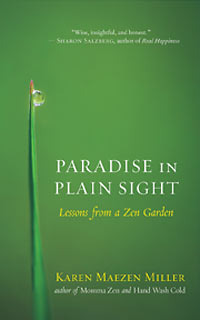 Come see the garden,” my new online friend said to me, years ago. We had never met, barely knew each other through the ether, and yet here she was, inviting me to her sanctuary.
Come see the garden,” my new online friend said to me, years ago. We had never met, barely knew each other through the ether, and yet here she was, inviting me to her sanctuary.
I was a New Hampshire housewife contemplating a field of granite rocks beyond my kitchen window. She was a west coast Zen priest, the rightful inheritor of a venerable Japanese garden tucked away in a suburb of LA.
What did we have in common? Perhaps it was something as simple as the belief that an ordinary life is a gift to be reckoned with — that folding socks and driving the carpool and washing supper dishes are opportunities for growth and grace. And we also shared this: a desire to fully inhabit the present moment by learning to pay attention to the ground beneath our own two feet.
It doesn’t sound like much — being quiet, noticing where you are, appreciating what you see, realizing that you already possess what you’ve been looking for because you already are everything you seek. Of course, this kind of seeing, this kind of unvarnished intimacy with one’s self, is also the task of a lifetime. Hard work. Simple. Not simple. Endless. Worth it.
So, perhaps it wasn’t a surprise that we first “met” because our books crossed each other’s doorsteps. Somehow mine, The Gift of an Ordinary Day: A Mother’s Memoir, found its way to her. Later, a twitter message from a stranger with a soon-to-be published book blinked onto my screen. Would I read a bound galley?
I would. I did.
And there in the pages of Hand Wash Cold: Care Instructions for an Ordinary Life I found a fellow pilgrim – no, more than that – I found a teacher. Here, as if delivered into my life by the universe, was a guide who could gently point my way forward on this endlessly challenging path called Paying Attention.
When you see your life, you bring it to life.” Yes.
Much later, when I finally did walk through Karen Maezen Miller’s front gate, she reached up and plucked an orange from a branch above us, placed it in my hands, and bowed deeply.
You are here for one purpose: to serve. Serving others will fulfill you as nothing else will.” Yes.
And then, our friendship sealed once and for all, I followed her — straight through the front door of the house and out the back, until we were standing in, well, paradise. I am tempted here to describe the garden. But instead, I’m going to let you discover it for yourself.
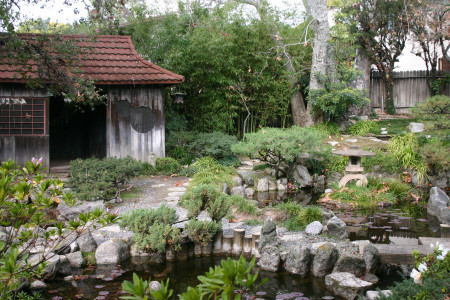 Sixteen years after giving up a life, a business, a home, an identity, and all certainty, to buy a run-down little house with a decrepit, hundred-year-old, overgrown Japanese garden that no one else cared to tackle, Karen Maezen Miller has written a book about her journey home and the lessons learned in her Zen garden. Of course, her journey is also your journey, and mine.
Sixteen years after giving up a life, a business, a home, an identity, and all certainty, to buy a run-down little house with a decrepit, hundred-year-old, overgrown Japanese garden that no one else cared to tackle, Karen Maezen Miller has written a book about her journey home and the lessons learned in her Zen garden. Of course, her journey is also your journey, and mine.
Each of is walking along a path with no sign of where we’ve been and no knowledge of where we’ll end up. The earth rises to meet the soles of our feet, and out of nowhere comes a gift to support and sustain our awareness, which is our life. Some days the gift is a bite, and some days it’s a banquet. Either way, it’s enough. Can you give yourself totally to the reality of your life and its unknowable outcome? When you do, the questions of where, when, how, and if will no longer trouble you.” Yes.
Last winter while visiting the west coast, I spent a night at Maezen’s house. As I was leaving in the morning, she handed me a manila envelope containing the first pages of Paradise in Plain Sight. It took me a long time to read those few opening chapters. I kept stopping, first to marvel at the almost magical events that comprise this very particular dharma story and then because, wildly different as our lives are, I saw myself on every page.
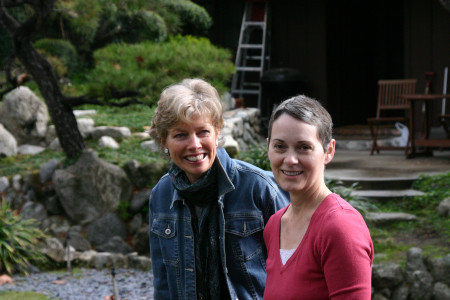 Have you ever read someone else’s memoir with the uncanny feeling that every paragraph has been written just for you? I am not a Zen practitioner. My garden has no history, let alone a plan or a purpose. I spend as much time wandering as I do sitting. And yet. The truth, delivered with such deep compassion, undid me. I wept and I laughed out loud. (Did I mention that Karen Maezen Miller is as funny as she is wise, as self-deprecating as she is compassionate?) I read more and more slowly. And then I went back and read again, with profound gratitude.
Have you ever read someone else’s memoir with the uncanny feeling that every paragraph has been written just for you? I am not a Zen practitioner. My garden has no history, let alone a plan or a purpose. I spend as much time wandering as I do sitting. And yet. The truth, delivered with such deep compassion, undid me. I wept and I laughed out loud. (Did I mention that Karen Maezen Miller is as funny as she is wise, as self-deprecating as she is compassionate?) I read more and more slowly. And then I went back and read again, with profound gratitude.
Love is abundant, but if you’re like me you may live a good part of the time thinking otherwise. That’s because love doesn’t always fit your idea of love. It doesn’t feel like you think it should. It doesn’t go your way . . .. Whatever you love will bring you to the final test of love: letting go of what you think love is.” Yes. (And, wow!)
If I were the host of a daytime TV show, I’d call it “The Journey Home.” I’d ask Karen Maezen Miller to be my very first on-the-air guest. And then I’d buy a thousand copies of Paradise in Plain Sight and put one under every single seat in the audience. That’s how certain I am that, no matter what you believe or what path you walk or what spiritual discipline you practice or what kind of row you hoe in your own backyard, this small, eloquent, powerfully provocative book will speak as directly to you as it does to me.
What will you do? First, don’t take my word alone as the truth. My words only point to paradise, the paradise waiting for you to bring to life. No garden looks like any other. Yours may not even be a garden. It may be a cracked sidewalk on a busy street, beside a river of roaring cars, headlights streaming nonstop in a noisy night. Your paradise may be a desert without a bloom, a kitchen without a window, a house now absent of love and laughter, short on the days and seasons you thought would last forever. I can only say this, me too. We are not so different from one another, any of us. There is one mind and we share it. One Way and we walk it. One path and it leads straight on. To see the whole of it you have to keep going and then keep going some more. When you come to the open ground, what will you plant? When will you tend it? How will you leave it?”
What I didn’t know, way back then as I spoke with Maezen on the phone the first time, is that she invites just about everyone to come visit the garden. That’s just how she is, and that’s also how she feels about this sacred bit of earth she’s been called to tend: it is meant to be shared. Not everyone takes her up on the offer, but those who do visit come away changed. “Pay attention,” Maezen advises her guests. “Bring all your attention to what is in front of you. You’ll wake up to the view and realize you’re right at home where you are.”
My advice? If you’re invited to visit a garden, any garden, go. And if you’ve ever sought a path, crossed a threshold, kneeled on the ground, planted a seed, and secretly yearned for life and love and roots to take hold, treat yourself to this beautiful book.
I can’t give away a thousand copies of Paradise in Plain Sight (much as I’d like to). But I do have one copy to share with you. And Karen Maezen Miller will sign it. In the meantime, take a stroll with Karen through her garden here.
To enter to win a signed copy
Just leave a comment below. Answer the question:
What do you tend in the paradise of your own back yard?
Or, you can simply say, “Count me in!”
A winner will be chosen at random before midnight on Friday, May 16.
Want to order Paradise in Plain Sight right now? Click here.
(As an Amazon affiliate, I receive a small commission on books sold through my site, which I use to order books to share here.)
The post Paradise in Plain Sight (and a give-away) appeared first on Katrina Kenison.
April 28, 2014
Why I write: “We still and always want waking”
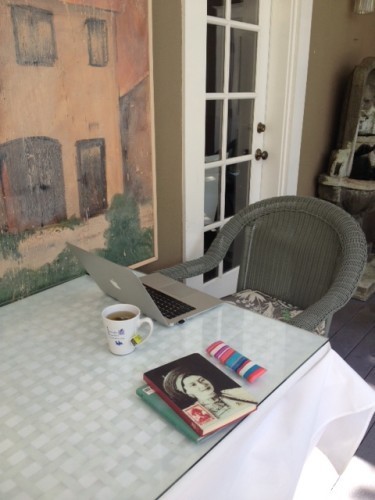 I’ve been fascinated, over the last month or so, to read so many of my favorite bloggers’ answers to the following questions about their writing process. (Don’t we all want to know what inspires the writers we love to do what they do?)
I’ve been fascinated, over the last month or so, to read so many of my favorite bloggers’ answers to the following questions about their writing process. (Don’t we all want to know what inspires the writers we love to do what they do?)
Today, thanks to Nicki Gilbert’s invitation, it’s my pleasure to hop on this train and try to put my own writing into some kind of context. And it’s an even greater pleasure to introduce three fellow writers I consider among my must-reads, Jeanne Henriques, whose gorgeous photos and vivid descriptions of her ex-pat life give rise to all sorts of fantasies; author Beth Kephart, who writes about books and the writing life with sustained insight, eloquence, and passion; and Amy VanEchaute, new to the blogging world and already accruing many devoted readers at her exquisitely executed site My Path With Stars Bestrewn.
A little background. . .
Fifteen years ago, when my two sons were small, I found myself haunted by a lack I couldn’t even name. I had a steady editing job I could do from home, babysitting help during those working hours, a comfortable house in the suburbs, two precious little boys and a husband I loved. A “good” life. And yet I juggled all the balls – mothering, working, household chores, activities, socializing, going and doing and getting – with a sense I was missing something essential. As my children grew and entered school, as I got busier and our days more complicated, this inchoate longing only intensified.
One afternoon, while sitting on the sofa with my five-year-old son, crocheting mitten strings as snowflakes drifted past the window, I finally realized what this painful yearning was: a desire to inhabit my own life more fully. Not to do more, but to be more. To have more quiet moments just like this one. And so I began systematically, and a bit ruthlessly, to simplify our family life. I also began to write about it. Having spent years as a literary editor, I never imagined myself as a writer. But suddenly I had something I wanted – actually, needed is not too strong a word here – to say. I needed to remind myself, again and again, what kind of person I wanted to be and what kind of life I wanted to lead.
Writing demanded that I sit still and pay attention. It required time, reflection and, most of all, a confrontation with my innermost self. If I really wanted to inhabit my life, it seemed, then the best way to do it was to slow down enough to notice the details. As I began to shape words, the words I wrote began to shape me. The more I saw, the more deeply I felt. And slowly, day by day and word by word, the hunger for something that always seemed just out of reach was transformed into gratitude for what was right in front of me.
I didn’t ever set out to write a trio of books charting the journey from mothering young children up through midlife and beyond. And yet, here I am.
What am I working on?
I’ve had the idea for a while to write a book I’m calling, for now anyway, “Offline: Reclaiming the Simple Pleasures of a Real-Time Life.” I spend way too much time sitting at my computer. And even when I’m not typing at a keyboard, my devices are ever present, woven through my days. I suspect I’m not alone in my concern about the complexity of our relationships with technology. I feel anxious if I forget my phone at home, yet I also wonder what it might be like to take a complete technology vacation. And much as I love the convenience of my fully wired life, I also miss the textures and challenges and diversity of my life as it was not so very long ago. I’d love to explore a different balance for myself, and write a collection of short reflections about rediscovering the beauty (and the necessity) of non-wired, hands-on experience.
I’m also in the process of compiling five years worth of blog posts into a small book. I thought this would be a quick project, but as it turns out, I want to revise and edit and turn them into a more thematically cohesive whole. So, it will take me a little longer than I thought, but I hope the results are worth it.
How does my work/writing differ from others in its genre?
Whenever someone asks what I write, I always find myself pausing awkwardly after my answer of “memoir.” To say I write memoir is to imply that I’ve confronted and overcome some kind of major life challenge that’s worth sharing with the world. Explaining that I write about my own ordinary, everyday life feels both incredibly self-absorbed and utterly boring. And yet, these really are my themes. I have no philosophy to share, no trauma to heal, no addiction to recover from, no dark secrets to reveal. My books aren’t exactly page turners!
Yet my hope, always, is that in writing from my own experience I also touch on something universal – perhaps simply our human desire to honor life as it is by illuminating the sacred in the everyday. There is a hidden meaning and beauty in life’s most ordinary moments, and deep inner work to be done as we wrestle with the inevitable questions that are part of every human existence. My writing tends to be quiet, exploratory, transparent, intimate. And perhaps what I’m trying to do is not so much tell the story of my own life, which is nothing special, but rather tell a story, which just happens to be mine, but that is also a reminder that what we have in common is greater than what keeps us apart.
Why do I write what I do?
I actually answered this question above, in my introduction. So instead of repeating myself, I’ll share a quote from Annie Dillard’s The Writing Life, a book I cherish. She answers the question of why we read and why we write better than anyone I know:
“Why are we reading, if not in hope of beauty laid bare, life heightened and its deepest mystery probed? Can the writer isolate and vivify all in experience that most engages our intellects and our hearts? Can the writer renew our hope for literary forms? Why are we reading if not in hope that the writer will magnify and dramatize our days, will illuminate and inspire us with wisdom, courage, and the possibility of meaningfulness, and will press upon our minds the deepest mysteries, so we may feel again their majesty and power? What do we ever know that is higher than that power which, from time to time, seizes our lives, and reveals us startlingly to ourselves as creatures set down here bewildered? Why does death so catch us by surprise, and why love? We still and always want waking.”
How does my writing process work?
I am a very slow writer and a terrible multi-tasker. A friend of mine keeps a notebook in the car and writes at traffic lights. Another writes on the train. I seem to require solitude and quiet and clear space and lots of uninterrupted time – which means I’m not very productive. I don’t write every day, because not every day affords me a luxurious stretch of vast silence. Nor am I one of those writers who needs to write in order to feel alive. I can feel very much alive and fulfilled by working in the garden or making dinner. And yet, if too many days go by without writing, I feel myself pulled to create that quiet place for myself. And once I sit down to work, I will go six or eight hours without even moving.
I wrote Magical Journey by pretty much holing up in a room for many months and writing for many hours a day, moving from my lair only to eat and sleep and take a walk so that I could go and sit again. I didn’t know, when I began, where the writing would take me. I had to begin as if I were embarking on a journey, put in the time, and see where the road led.
When I sit down to write a blog post, it’s the same; I begin right where I am without really knowing where I’m going. Eight hours later, I’ve arrived somewhere. I take a break, go do something else to clear my head, then come back and edit and revise. I’m embarrassed to admit how long it takes me to write a simple blog post. And I’m a bit in awe of anyone who posts more than once a week.
Meet my fellow blog hop writers. . .
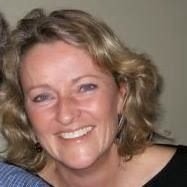 Jeanne Henriques is wife to a nomadic husband, mother to four independent children, one well-travelled dog and is the writer behind the blogs, Collage of Life and Expat Diary Viet Nam. Over the past 26 years, her family has packed up and moved between America, Australia, New Zealand, UK and Vietnam. She has some ideas of when and where the Expat Express will go next but can never be certain. Jeanne recently added “empty nester” to her repertoire with her four children now living between America and Australia. She looks to the years ahead as an opportunity to explore new horizons. She hangs her hat and camera part of the year at Chateau Mango in Ho Chi Minh City, Vietnam and the other half at Tahilla Farm in the foothills of the Monadnock mountain range in New Hampshire. She writes to tell the tale. You can follow her adventures on her blogs, Collage of Life, and Expat Diary Viet Nam. Jeanne can also be found chatting on Twitter, Instagram and Facebook.
Jeanne Henriques is wife to a nomadic husband, mother to four independent children, one well-travelled dog and is the writer behind the blogs, Collage of Life and Expat Diary Viet Nam. Over the past 26 years, her family has packed up and moved between America, Australia, New Zealand, UK and Vietnam. She has some ideas of when and where the Expat Express will go next but can never be certain. Jeanne recently added “empty nester” to her repertoire with her four children now living between America and Australia. She looks to the years ahead as an opportunity to explore new horizons. She hangs her hat and camera part of the year at Chateau Mango in Ho Chi Minh City, Vietnam and the other half at Tahilla Farm in the foothills of the Monadnock mountain range in New Hampshire. She writes to tell the tale. You can follow her adventures on her blogs, Collage of Life, and Expat Diary Viet Nam. Jeanne can also be found chatting on Twitter, Instagram and Facebook.
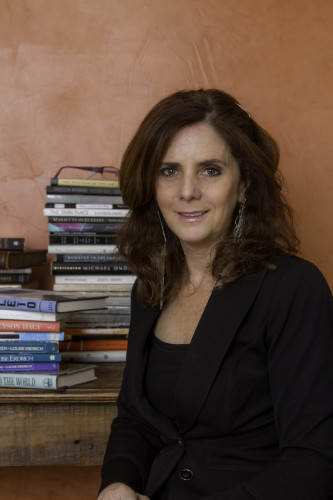 Beth Kephart is the award-winning author of eighteen books, an adjunct professor of creative nonfiction at the University of Pennsylvania, a frequent contributor to the Chicago Tribune and Philadelphia Inquirer, and the strategic writing partner in a boutique marketing communications firm. Handling the Truth: On the Writing of Memoir won the 2013 Books for a Better Life Award (Motivational Category). Nest. Flight. Sky., Kephart’s first memoir in years, was recently published by Shebooks. Most recently, Beth’s ninth young adult novel, Going Over (Chronicle Books), a 1983 Berlin story and a Junior Library Guild Selection, was launched to three starred reviews and was named a Booklist Top Ten Historical Fiction for Youth. Beth writes about books and writing and life at Beth Kephart Books.
Beth Kephart is the award-winning author of eighteen books, an adjunct professor of creative nonfiction at the University of Pennsylvania, a frequent contributor to the Chicago Tribune and Philadelphia Inquirer, and the strategic writing partner in a boutique marketing communications firm. Handling the Truth: On the Writing of Memoir won the 2013 Books for a Better Life Award (Motivational Category). Nest. Flight. Sky., Kephart’s first memoir in years, was recently published by Shebooks. Most recently, Beth’s ninth young adult novel, Going Over (Chronicle Books), a 1983 Berlin story and a Junior Library Guild Selection, was launched to three starred reviews and was named a Booklist Top Ten Historical Fiction for Youth. Beth writes about books and writing and life at Beth Kephart Books.
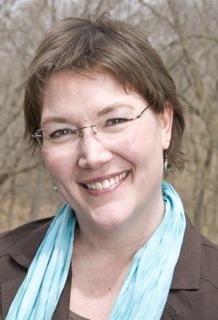 A self-described closet writer who surprised herself by making the decision to dip a toe into the blogosphere this year, Amy VanEchaute lives in Illinois with her husband, Jeff. Together, they’ve raised three (splendidly) literate children. Amy studies and reveres nature, subsists on poetry, and chooses peace for her daily portion. She enjoys sharing her photos and her perspective on My Path with Stars Bestrewn.
A self-described closet writer who surprised herself by making the decision to dip a toe into the blogosphere this year, Amy VanEchaute lives in Illinois with her husband, Jeff. Together, they’ve raised three (splendidly) literate children. Amy studies and reveres nature, subsists on poetry, and chooses peace for her daily portion. She enjoys sharing her photos and her perspective on My Path with Stars Bestrewn.
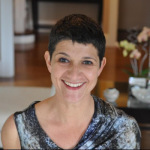 South African by chance and Californian by choice, Nicki Gilbert lives in the Bay Area with her husband, four kids and an aging dachshund. With dreams of reporting live on CNN, she majored in Drama and Journalism at Rhodes University in South Africa, met a boy, married him and moved almost 180 degrees west to San Francisco, to live her life as a wife, marketer, event coordinator, non-profit board member, and eventually stay-at-home mom. There was very little writing and even less acting during those years. Last year Nicki started blogging for Times of Israel, and now writes on her own website Red Boots – from dancing to walking and everything in between, and beyond. As a reluctant yet full-time, barely-at-home mom, writer, avid reader, country music lover and wannabe surf diva, she writes to keep perspective about it all. With tears, humor, skepticism, love, pain and truth. Trying to keep it real. Follow her at www.redboots.me and on Twitter @nixgilbertca.
South African by chance and Californian by choice, Nicki Gilbert lives in the Bay Area with her husband, four kids and an aging dachshund. With dreams of reporting live on CNN, she majored in Drama and Journalism at Rhodes University in South Africa, met a boy, married him and moved almost 180 degrees west to San Francisco, to live her life as a wife, marketer, event coordinator, non-profit board member, and eventually stay-at-home mom. There was very little writing and even less acting during those years. Last year Nicki started blogging for Times of Israel, and now writes on her own website Red Boots – from dancing to walking and everything in between, and beyond. As a reluctant yet full-time, barely-at-home mom, writer, avid reader, country music lover and wannabe surf diva, she writes to keep perspective about it all. With tears, humor, skepticism, love, pain and truth. Trying to keep it real. Follow her at www.redboots.me and on Twitter @nixgilbertca.
Might there be a writing retreat in your future?
I took the photo above of my “outdoor office” at The Lavender Inn , in Ojai, California, where my husband and I stayed while on vacation last month. It is, quite simply, a writer’s paradise. I want to share this exquisite experience! So, I’ve reserved the entire inn for 3 nights next March (22-24), to host a small writers’ retreat. I’ll have all the details here soon. But if you think you might be interested, write me here and let me know. Space will be limited to 10.
The post Why I write: “We still and always want waking” appeared first on Katrina Kenison.
April 19, 2014
Dear Old(er): aging with grace
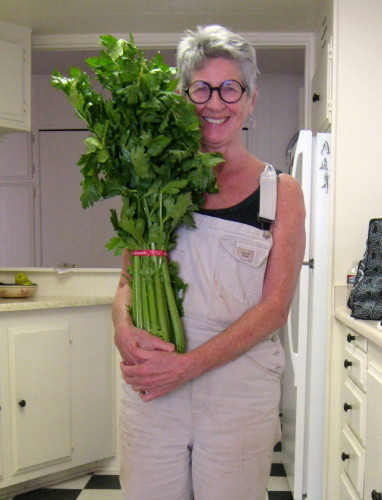
This is the third in a series of letters between me and my friend, author Margaret Roach, on the challenges (and joys!) of aging. I’m Old (just 55) and she’s Older (facing 60 this year). And since we’re surely not the only ones buying wrinkle creams, we decided to share our exchange with you, too. Be sure to read Margaret’s letter to me .
Dear Old(er),
I’m thinking maybe we should come up with some new words for us.
Have you noticed that a few of our (older) readers have pointed out that, at 55 and 60, we aren’t quite “there” yet? My guess: to them we look less like a pair of wise elders and more like a couple of adolescents who are insisting they’re adults and want to be treated as such. No matter that our curfews these days are entirely self-imposed or that, rather than indulging in hedonistic excess, we’ve pretty much renounced all our youthful vices. The point is, if we’re old now, what will we call ourselves at 85 and 90? (We are planning to be writing to each other thirty years from now, right?)
At first I didn’t think much of it. I certainly feel old many mornings, as I gently lift my creaky left leg over the side of the bed, confront the wrinkles in the mirror, and brush a bit of concealer over the dark circles under my eyes.
But lately it’s occurred to me that maybe we haven’t really earned the right to our epistolary nicknames here. True, “middle-aged” doesn’t quite fit either, since we’re both technically on the back side of the middle, somewhere in the grayish two-thirds territory – well beyond the half-way mark, not yet approaching the end, and still advancing along the path on our own two feet.
Yet, I have to say, lately even the “old” people I meet don’t seem all that old.
I’m thinking, for instance, of Helen (that’s her up top), who is 81 and works in a hip little boutique in Ojai, California, where we met while I was on vacation last month. I stopped in to try on a pair of shoes and ended up staying to chat for half an hour, so much did we find in common.
Helen took up yoga in her fifties and went on to get certified as a teacher. She and her husband bike around town on a red tandem and teach yoga to anyone who’s ready to release a little fear and open up to a little love. That’s the kind of practice they do, meeting students exactly where they are. Between her “real” jobs, Helen volunteers at a local organic farm. I think she looks pretty great in those overalls, but she also happens to be a great model for the lovely clothes she sells. With her short, chic, silver hair, her funky round eyeglasses, dangly earrings, pedicured toes, and cool, chunky sandals, she just doesn’t fit any of my “old” stereotypes. If I had to describe her, old isn’t even a word that would come to mind. She is beautiful, alive, warm, lithe, engaging, compassionate, open, curious, fun. If I lived in Ojai, I’m pretty sure we’d be great friends. Instead, we exchanged email addresses and made plans for a yoga date next March, when I return.
I think of Pat, who was in the audience at a talk I gave last week. I spoke about change and loss, and about letting go of old roles and routines and dreams, to make space for new ones to begin to take shape. After everyone else had left, Pat stayed behind to clear tables and empty trash. “I’m 85,” she said, “and I’ve let go of a lot, including my husband. I couldn’t imagine how I’d go on after he died. But I did, and now, I have to tell you, I love my life.” Pat explained that she didn’t need to rush home to a family, so she could stay out late and help with clean up. She didn’t expect any special treatment; in fact, the opposite. “I just look around to see how I can be useful,” she said, folding a tablecloth into neat thirds.
And then there’s Shirl, who’s 88 and just getting back to yoga this spring after having to take the winter off. “I had an operation on my eyes,” she explains, “so I couldn’t put my head down for a while. Right after that, there was the time change, and I don’t drive after dark anymore. So I missed the whole winter, but now it’s light at 5:30, and here I am.”
Indeed. Her balance is a little wobbly, and her hearing not what it once was. But her forward bend is graceful and quiet, her delight in her practice palpable, her spirit infectious. She gives me a friendly wink and a wave from across the room. Did I mention that Shirl comes to class in a pair of pink sweatpants with two words across the back: Bad Ass? “My grand-daughter gave me these,” she says, her eyes crinkling at the corners. “And I figure, at my age, I can wear whatever I want.”
I tell Shirl that when I’m 88, I want to be like her, climbing up the stairs to yoga class and stretching my hamstrings and wearing pink. She laughs, takes my arm, and says, “Oh, dear, I hope you’ll be better than I am.”
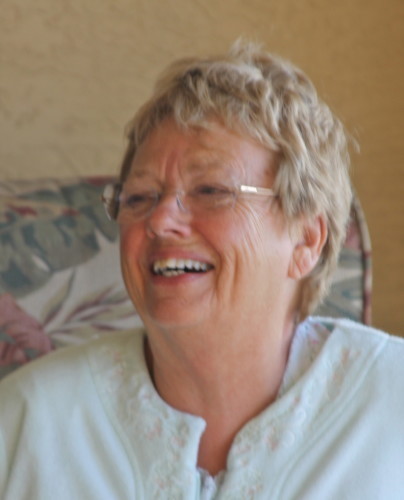 My own mother, 78 and battling Lyme disease, isn’t moving as quickly as she was just a short time ago. But to me, she’s aging in reverse. When I was 17, she seemed really old to me, an ancient thirty-something who couldn’t possibly understand what it was like to be young. But now, almost forty years later, I don’t think of her as old at all. Our mother-daughter friendship is so precious, and her perspective on things so fresh and insightful, that I think of her as more of a peer than a parent. My mom is my best friend and a constant source of inspiration and encouragement. Who else would chop a bunch of CSA vegetables to roast, see the beauty in nature’s artistry, and share it with me in a photo? (Snapped with her iPhone, no less.) Old? Not! Curious, joyful, perceptive? More so than ever before.
My own mother, 78 and battling Lyme disease, isn’t moving as quickly as she was just a short time ago. But to me, she’s aging in reverse. When I was 17, she seemed really old to me, an ancient thirty-something who couldn’t possibly understand what it was like to be young. But now, almost forty years later, I don’t think of her as old at all. Our mother-daughter friendship is so precious, and her perspective on things so fresh and insightful, that I think of her as more of a peer than a parent. My mom is my best friend and a constant source of inspiration and encouragement. Who else would chop a bunch of CSA vegetables to roast, see the beauty in nature’s artistry, and share it with me in a photo? (Snapped with her iPhone, no less.) Old? Not! Curious, joyful, perceptive? More so than ever before.
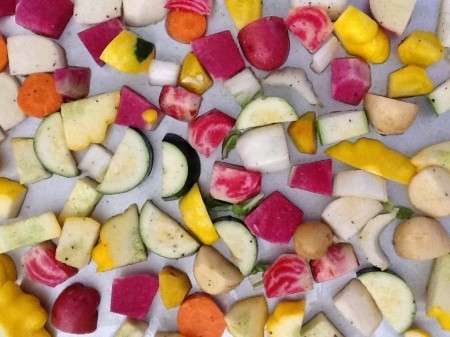 Finally, we must consider Gloria. Gloria Steinem celebrated her 80th birthday a couple of weeks ago by presiding at a fundraiser in Philadelphia. And then, the next day, she flew off to Botswana. According to a recent article in the New York Times, she asked herself, “What do I really want to do on my birthday? First, get out of Dodge. Second, ride elephants.”
Finally, we must consider Gloria. Gloria Steinem celebrated her 80th birthday a couple of weeks ago by presiding at a fundraiser in Philadelphia. And then, the next day, she flew off to Botswana. According to a recent article in the New York Times, she asked herself, “What do I really want to do on my birthday? First, get out of Dodge. Second, ride elephants.”
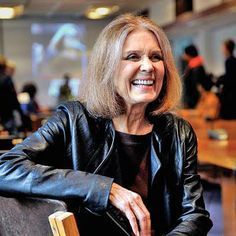 See what I mean? These women, so much older than us, aren’t exactly old, are they?
See what I mean? These women, so much older than us, aren’t exactly old, are they?
So where does all this leave the two of us? Well, I keep doing the math and finding it somewhat reassuring. If our luck holds and if we take good care of ourselves, we might get to follow in their sprightly footsteps. Blessed with a couple more decades, twenty or even thirty years more on the planet, what shall we do? How will we keep life meaningful?
When I think of all the time I spent in my younger days trying to figure out who I should be and what I should do and how I should look, I’m pretty grateful to be exactly where I am. At fifty-five, and aware as never before of life’s preciousness, its fleetingness, its randomness, I finally do know what matters, or at least what matters to me. Keeping a sense of wonder, for sure. And this: loving well and being loved in return.
So maybe it’s not surprising that something one of Gloria’s friends told the Times reporter really hit home with me, too. Robin Morgan, a fellow feminist from the early days, says one change she’s noticed with age is a deeper appreciation for the special, intimate relationships that sustain us.
“I’ve noticed that we, all of us, sort of cling to each other more,” she said. “We say ‘I love you’ at the end of conversations. We call to say ‘It’s very cold out – did you wear an extra scarf?’ There’s a lot of tenderness.”
Tenderness. I love this word and all it represents.
No longer in ascension but not exactly in decline yet either, no longer needed by anyone in the way I once was, I do still have something to offer the world — though I’m not always quite sure just what. Most days, I figure out my next step by standing still, looking around, and asking the same question Pat does: “How can I be useful here?”
Well, maybe my answer comes down to this one rather old-fashioned word. Tenderness.
Tenderness toward my own imperfect, vulnerable, aging self. Tenderness toward my young adult sons as they flail and fall and find their way into lives of their own. Tenderness toward my husband, ten years older than me, as he looks ahead and does his math and tries to form a vision for our next chapter together. Tenderness toward my dear friends and loved ones – for aren’t we all absorbing losses and meeting challenges in our lives, even as we discover some unexpected new freedoms? Tenderness for all beings, including those who struggle simply to stay alive and those who struggle to lead us forward. Tenderness for the earth itself, resilient and vulnerable and in need of our care.
My guess is there’s nothing and no one in this vast, needy world that couldn’t benefit from a bit of unconditional tenderness.
So I’m thinking — maybe the best way to stave off the encroaching sense of ourselves as “old,” and all the diminishment the word implies, is simply to take a cue from some mentors in the art of growing older. There’s an organic affinity, as William James astutely observed, between joy and tenderness. It sounds right to me; joy and a youthful spirit are the side-effects of loving –– perhaps not quite so passionately as we once did, but more wholeheartedly and tenderly than ever.
Back to my idea of coming up with a label for this nameless liminal space between mid-life and old age. How about the Tender Years?
Love, Old
P.S. It’s still chilly out there. Are you wearing your jacket? And did you hear that concert the birds put on just before sunrise?
(P.S. To our readers: Margaret is , with her latest letter to me. And if you missed our first letters, they are here.)
The post Dear Old(er): aging with grace appeared first on Katrina Kenison.
April 10, 2014
present moment — and a mother’s day give-away
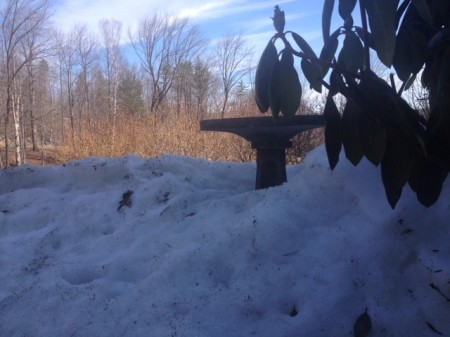 I’m still waiting for the last snow bank to melt outside the back door. My guess is it’ll linger, grainy and gray, for another week or so.
I’m still waiting for the last snow bank to melt outside the back door. My guess is it’ll linger, grainy and gray, for another week or so.
I suppose I could get out there today and attack winter’s last frozen carapace with a shovel. If I got that mound of snow and ice all broken up and spread out on the flattened, spongy lawn, it would probably disappear faster.
Instead, I look at winter’s grimy remains and see an invitation to pay attention. The lingering, slowly dwindling snow bank reminds me once again: nothing lasts. Even the harsh, seemingly endless winter I complained about and struggled against for months is finally on its way out, its last vestiges vanishing by the moment.
On this windy, chilly spring day, it’s too early to do much of anything productive outside. And so, I walk around and survey the wreckage: the old front gate, broken off at the hinge, the fallen tree limbs, the cache of dead leaves in the window wells, the skeletal remains of the Christmas tree on the patio, the dead hydrangea blooms I never got around to pruning in the fall. I could easily get overwhelmed by the to-do list formulating in my head — so much work to be done.
Instead, I simply look around in wonder at the relentless, reassuring continuance of Nature. The year has its rhythms, its phases, as do I. There is a time to honor the winter of the soul, to turn inward and rest, gathering potential for the next season. And there’s a time to gently clear space for what’s greening inside, waiting its moment to emerge.
It occurs to me that, for today at least, I’m being offered an opportunity to straddle two seasons here. I can step out my back door, rest a bare palm on gritty snow that’s been fallow since November’s first storm, and recall the hard lessons of winter: accept the cauterizing cold, welcome the darkness, surrender your well-laid plans, let go into things as they are, practice patience, have faith.
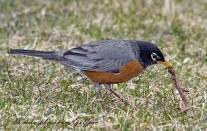 Or, I can simply round the corner, to the southern side of the house, and inhale the eager elation of spring. Out here, an entire flock of robins have landed, as if to celebrate the thaw; they are busily extracting worms from the spongy grass.
Or, I can simply round the corner, to the southern side of the house, and inhale the eager elation of spring. Out here, an entire flock of robins have landed, as if to celebrate the thaw; they are busily extracting worms from the spongy grass.
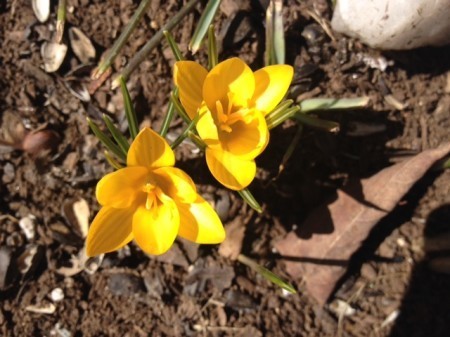 Over by the stone wall, a lone yellow crocus has asserted itself where, just yesterday, there was nothing but bare ground. There are crimson peony shoots pushing forth just outside the kitchen door, too, as if they’ve been waiting impatiently to take their rightful place. It is mid-April, after all.
Over by the stone wall, a lone yellow crocus has asserted itself where, just yesterday, there was nothing but bare ground. There are crimson peony shoots pushing forth just outside the kitchen door, too, as if they’ve been waiting impatiently to take their rightful place. It is mid-April, after all.
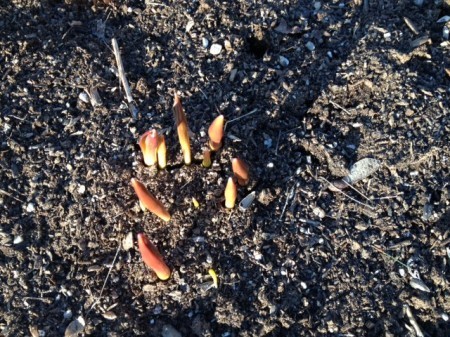 Standing out in my bare garden, face tipped up to the sun, I marvel at just how much life pulses in a single moment. It seems there’s something stirring in me, too: permission to grow and stretch and break some new ground.
Standing out in my bare garden, face tipped up to the sun, I marvel at just how much life pulses in a single moment. It seems there’s something stirring in me, too: permission to grow and stretch and break some new ground.
Don’t get caught in the past,
because the past is gone.
Don’t get upset about the future,
because the future is not yet here.
There is only one moment for you to be alive,
and that is the present moment.
Go back to the present moment
and live this moment deeply,
and you’ll be free.
~ Buddha
(with thanks to Claudia Cummins at First Sip)
What’s greening these days in your backyard, or in your heart?
Thinking ahead to Mother’s Day
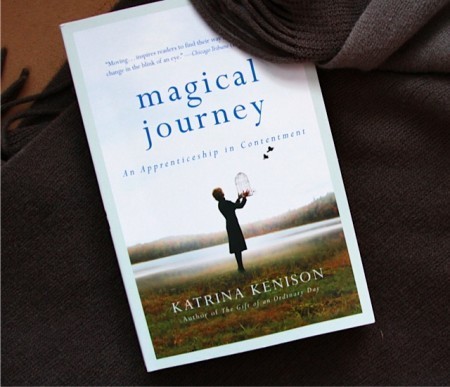 IT’S COMING RIGHT UP – MAY 11!
IT’S COMING RIGHT UP – MAY 11!
first, the give-away:
Know a mom who likes to listen to books? I have 3 copies of “Magical Journey” on Audible to give away.
To win, just post a line from “Magical Journey” on Facebook (any line you really liked!).
Tag me in your post. Then leave me a comment here.
On April 28, I’ll choose 3 winners at random.
The Audible version of “Magical Journey” will be delivered, as a gift, to the e-mail inbox of your choosing. (And you get to write a personal message to accompany it.) I read the book myself — a wonderful, intimate experience. To hear an excerpt, Click here. (Or, to order, click here.)
now, some gift-giving options:
I’d be honored to have you share any of my books with a special mom in your life. And I want to make that easy for you!
If you’d like a book –or books!– personalized and signed, click here to link to my wonderful local bookstore. When you fill out the form, include anything you’d like me to write. Want your books gift-wrapped? They will happily do that, too! Perfect!
2. Buying your books elsewhere? As always, I have a stash of bookplates – lots! A bookplate makes any book a lovelier gift. Ask for as many as you can use. Click here. (Be sure to include the names of your recipients, and your mailing address. Postage is on me!)
**Congratulations to Amy Robertson, winner of a copy of Motherhood Realized.
The post present moment — and a mother’s day give-away appeared first on Katrina Kenison.
April 4, 2014
Laurie Colwin — my mentor in the kitchen & on the page
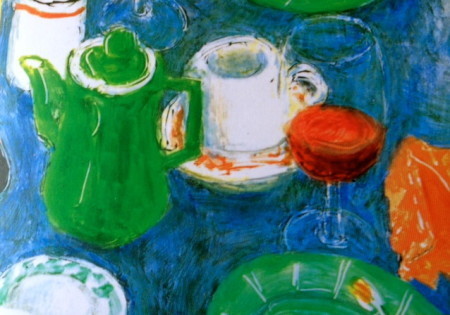 I once bought a black speckled canning pot, two boxes of Ball jars, and twelve pounds of dusky Italian plums in memory of an author I loved.
I once bought a black speckled canning pot, two boxes of Ball jars, and twelve pounds of dusky Italian plums in memory of an author I loved.
For years, I’ve suspected I was one of a few remaining Laurie Colwin aficionados, a smallish but loyal band of readers of a certain age and sensibility who still hold her close in our hearts, afford her books prime space on our shelves, and continue to make her signature dishes in our kitchens.
So it was rather wonderful, though a bit startling, to discover in the pages of the New York Times this week that I’m not alone after all. That in fact, in the more than twenty years since her death, Laurie’s following has only grown, attracting “a new, cultishly devoted generation of readers,” many of whom are in their thirties or even younger.
Turns out, Laurie Colwin is bigger than ever. Her books, never out of print, are selling briskly. Some of her most zealous disciples today were toddlers when she died in 1992. Somehow, knowing about her expanding fan base gives me hope — not only for this new generation of readers, secret romantics, and home cooks, but also for the survival of such humble institutions as tea parties, afternoon picnics, and family dinners.
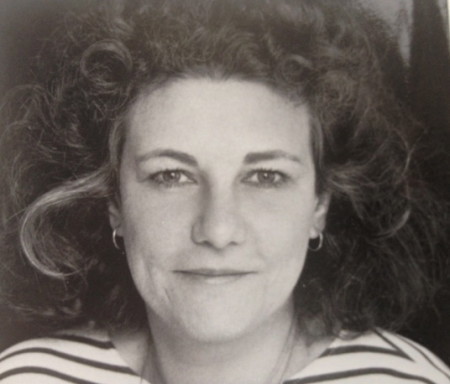 I knew Laurie only slightly. Back in the mid-eighties, she agreed to read in a short story series a friend and I were producing, pairing well-known writers with our latest literary discoveries. We’d barely been introduced backstage when Laurie asked if I would retie her scarf, a slippery, oversized square of silk that proved impossible for either of us to get just right.
I knew Laurie only slightly. Back in the mid-eighties, she agreed to read in a short story series a friend and I were producing, pairing well-known writers with our latest literary discoveries. We’d barely been introduced backstage when Laurie asked if I would retie her scarf, a slippery, oversized square of silk that proved impossible for either of us to get just right.
I was twenty-five, longing for passionate love and domestic bliss, and she was, hands-down, my favorite living writer. I often felt in those days as if I were meeting alternate versions of myself in Laurie Colwin’s stories, which I read and re-read as if they were medicinal. In a way, perhaps, they were.
Newly separated from a miserable but well-intentioned first marriage, I was ashamed of the embarrassing mess I’d already made of my life. Laurie’s characters — good, honorable souls all — often found themselves haplessly entangled as well. I found solace in their romantic missteps and hope in their ability to survive life’s ambiguities. “Falling in love is not a mistake,” insists a character in The Lone Pilgrim – curative words for my own bruised heart.
Backstage that night, my hands shook a bit as I fussed with the ends at her neck, trying to make them lie flat. I remember exactly what I was thinking: “Life is full of astonishment. I am standing in the wings of a New York theatre, tying Laurie Colwin’s scarf!”
After that, a mutual publishing friend began inviting both of us to his dinner parties. For a time, our paths crossed. I was always a bit in awe of her wit and charm, and I think she, fourteen years older and almost preternaturally maternal, liked the idea of keeping a watchful eye on me.
Once, after I’d fallen in love with my future husband and left New York to marry him, Laurie and I met for lunch when I was back in the city. She loved a romantic story with a happy ending and I was flattered that she wanted to hear every last detail of mine.
We sat outside at a deli around the corner from her Chelsea apartment. I know we shared an enormous corned beef sandwich at her suggestion, because later I wrote it down. She asked me about children and I told her, yes, I was trying — without success.
Laurie leaned across the table, suddenly intent, her face framed by a huge halo of untameable dark hair. What had I tried? What drugs had I taken? What was I doing and how often was I doing it? She was certain I needed to work less and eat more. Surely I needed more sleep, too. And I needed to see her doctor right away; she would make sure I got in. I was pushing thirty, she pointed out, and there was no time to waste.
It’s funny, the details the mind files away. And for me this one remains indelible: an impassioned Laurie Colwin insisting I had no time to waste. She wrote her gynecologist’s name on a white deli napkin and handed it to me. “Call him,” she said. “The man can get a stone pregnant.”
After lunch, we walked a few blocks to pick her daughter Rosa up at school and then back to their cozy, cluttered apartment. It seemed perfectly familiar, almost as if I’d been there before, though of course I hadn’t; I’d just read enough of Laurie’s descriptions of home to recognize hers: “small but crammed with artifacts: watercolors, family photographs, teapots, pitchers, and beautiful plates.”
We had tea in the kitchen as the late afternoon light streamed in. Less than six months later, I was pregnant. I never saw her again.
The news that Laurie had died, suddenly and in her sleep of heart failure, on October 23, 1992, stunned everyone. Her death seemed unfathomable – she was only 48; she had a young child, a husband; she was fully engaged in living and writing and volunteering at the soup kitchen near her home where she was on a first-name basis with all the regulars. And then, overnight, she was gone.
I was eight months pregnant with my second son, standing in the sunshine on our back porch in the suburbs when the call came from a friend. Although Laurie and I weren’t often in touch, I’d happened to talk with her just a few weeks earlier about being the guest editor the following year for The Best American Short Stories. I promised her we’d have fun. She hadn’t hesitated before saying yes. It took a few minutes before my tears began to fall, as if my heart simply refused to admit the news.
And yet, despite these brief but precious memories, my real relationship with Laurie Colwin has always been that between a writer and a reader. As a miserable twenty-three-year-old married too soon and to the wrong man, I wept and took heart reading Laurie’s short stories, encouraged by her conviction that there is a fine, flawed person at large in the world destined eventually to find his or her way to each one of us. Love, she believed, was unpredictable, often painful, sometimes blind, always worth waiting for. And, as her characters inevitably realize: even happiness takes work.
When I was home sick with a cold, or exhausted, or feeling sorry for myself, I’d take to my bed with a box of tissues and my favorite novel, Happy All the Time. Inevitably I’d come across a description of a restorative cup of tea, or a perfect cheese omelet, or a full-bodied glass of wine – descriptions so seductive that I’d always be roused to get up and wander into the kitchen to fetch a little something for myself. It was simple: when I was miserable in my twenties – whether due to matters of the heart, the spirit, or the body – reading Laurie Colwin made me feel better.
Later, married to the right man and raising our two children, I began to read Laurie’s essays about food with the same kind of deep, personal affinity I’d always felt for her fiction. She wrote about eating a tomato from the garden with as much rapture as another writer might bring to a climactic love scene. She could make eggs sexy, cold coffee appealing, lentil soup sound festive, old Bristish cookbooks compelling. She inspired me to throw more dinner parties, to “build” better sandwiches, to go in search of my first organic egg and to exhaust my arm stirring my first pot of polenta.
And she was surely the only writer on earth who could tempt me to cook a lima bean casserole, simply by recounting the contentment this unlikely party fare brought to the group of friends upon whom she bestowed it one wintery night.
For Laurie, it was all one in the same, romantic love blending seamlessly into culinary exuberance and from there into a generous, high-spirited passion for life itself. She was, like her heroine Polly in The Lone Pilgrim, a domestic sensualist, reveling in the enchantments of everyday existence. And although the essays that became Home Cooking and More Home Cooking were ostensibly about cooking and eating and feeding people, these two casually intimate volumes are in fact sublime celebrations of love and friendship and family – each one as much memoir as cookbook, the wealth of enticing recipes not withstanding. To step into these pages was to find a friend not only to stand at my side in the kitchen but to accompany me through the vagaries of my own newly domestic life as well.
Laurie’s essays – in which she somehow manages to be anecdotal, funny, affectionate, and informative all at once – shone a light on the path as I became a wife and a mother myself. Drawn into her confidence on the page, I felt as if I’d come to know at last this generous, quirky, brilliant woman who got dressed up every year for Halloween, ate stewed eggplant right out of the saucepan, and baked gingerbread on a weekly basis for her little girl.
You do not have to be a housebound mother to make gingerbread. All you need is to put aside an hour or so to mix up the batter and bake it, and then, provided you do not have a huge mob waiting to devour the gingerbread immediately, it will pay you back for a few days because it gets better as it ages.
Cooking, Laurie continually reminds us, needn’t be drudgery but rather an ongoing expression of affection and creativity. And the dinner table isn’t just a place to serve food, but also the ideal setting to create and sustain traditions, to nurture oneself and others, to weave the invisible mantle of memory and intimacy and security that holds us gently in place in a fast-moving world.
It took me a long time to get over my fear of making jam. The whole enterprise seemed terrifying. After all, entire factories were devoted to its manufacture, so how was I, one small person in an inadequate kitchen, supposed to compete?
Reading about Laurie’s “jam anxiety” I was surprised to discover she’d been as leery of sterilizing jars as I was. She was gone by the time I finally got around to trying jam myself, but I liked to imagine that somehow, somewhere, she was watching out for me still.
I bought the canner and my first load of ripe plums because she convinced me I was up to the job – which, of course, I was. For many years, making Laurie Colwin’s plum jam each October felt like a way of sustaining the ineffable, eternal thread that bound us, a writer who left the world too soon and her grateful reader, still here in it.
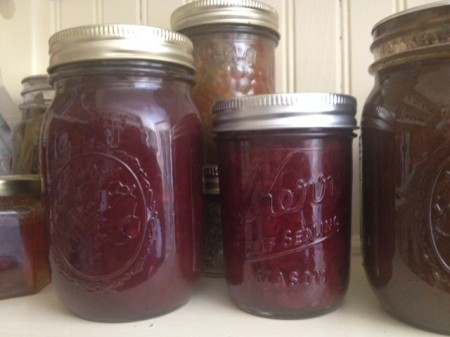 Perhaps we all look for guides and mentors along the way, people who suggest by example a way of being in their own skin that prompts us to take notice because it feels right to us, too — and even worth emulating. Laurie Colwin was that kind of guide for me, simply by living her life so fully and writing about it so generously. I would seek her advice on roasting a chicken and what I received along with it, always, was a reminder to savor my hour in the kitchen and the precious people gathered at my table for the meal.
Perhaps we all look for guides and mentors along the way, people who suggest by example a way of being in their own skin that prompts us to take notice because it feels right to us, too — and even worth emulating. Laurie Colwin was that kind of guide for me, simply by living her life so fully and writing about it so generously. I would seek her advice on roasting a chicken and what I received along with it, always, was a reminder to savor my hour in the kitchen and the precious people gathered at my table for the meal.
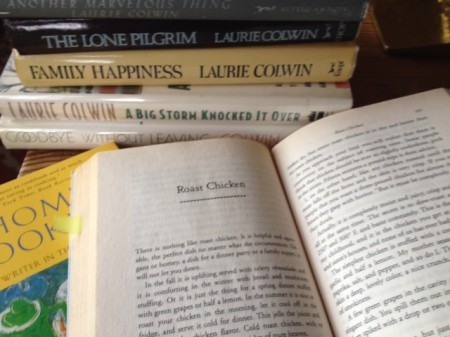 Throughout my years of editing and writing books and raising children to adulthood — as I brewed my morning cup of coffee, peeled carrots, baked bread with my little boys, put dinner after dinner after dinner on the table, listened to the rise and fall of deepening male voices and the clatter of silverware – I’ve thought of Laurie many times. The lessons she taught, both in her writing and by dying right in the middle of her living, have shaped me both as a person and as a writer. And certainly this is one: to fully embrace the delicious, irretrievable, ordinary moment that is now.
Throughout my years of editing and writing books and raising children to adulthood — as I brewed my morning cup of coffee, peeled carrots, baked bread with my little boys, put dinner after dinner after dinner on the table, listened to the rise and fall of deepening male voices and the clatter of silverware – I’ve thought of Laurie many times. The lessons she taught, both in her writing and by dying right in the middle of her living, have shaped me both as a person and as a writer. And certainly this is one: to fully embrace the delicious, irretrievable, ordinary moment that is now.
In the fall of 1992, in a burst of enthusiasm – or prescience? –Laurie composed a whole year’s worth of columns for Gourmet and sent them off to her editor. The magazine ran those pieces posthumously, and so it was that each month over the next year, as I negotiated the demands of an infant and a toddler, Laurie arrived in my house in the glossy pages of a magazine, sharing her recipes, her humor, her heart.
Her Thanksgiving column appeared in Gourmet the month after she died. A reflection on the evolution of her own Thanksgiving dinner, it included her recipes for cider jelly and rosemary nuts (a treat I continue to make and give away to this day). She concluded:
This menu is now my tradition, but I know that in not too long a time my daughter will grow up and decide that it is her turn, and we will travel to her household for Thanksgiving. And there I will find the traditional meal, totally renovated and redesigned: the beginning – for that is the way these things go – of a new tradition.
Last year, for the first time, my mother passed the Thanksgiving baton to me. I labored over the stove for two days, prepared her traditional meal for our family, and sighed with relief when she nodded her approval, aware that the end of one chapter had given rise now to the beginning of a new one. This, as Laurie observed, is “the way these things go.” Nothing lasts forever.
And yet, we show up for as long as we are able and we carry on anyway, passing the old recipes along, bringing out the good dishes, and reminiscing about years gone by – in the hope that we’ll have a chance to do it all over again next year.
For what do any of us wish for, really, other than to be granted another day just like this one? Another trip to the farmer’s market, a hummingbird in the garden, a sun-kissed tomato straight from the vine, a pot of soup to share with family and friends, a pan of dense, spicy gingerbread eaten warm—the immeasurable, ephemeral joy of life itself.
The post Laurie Colwin — my mentor in the kitchen & on the page appeared first on Katrina Kenison.
March 27, 2014
Motherhood Realized
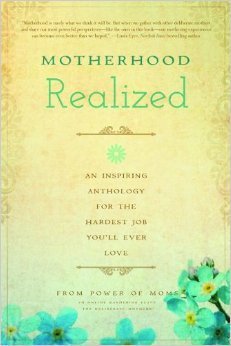 Flying to the west coast recently, I found myself seated on the plane alongside a young couple. They appeared to be about twenty-four or so, the same age as my own older son. She, five months pregnant, was immersed in a how-to book about mothering newborns. He, sweet but distracted, played a video game on his computer.
Flying to the west coast recently, I found myself seated on the plane alongside a young couple. They appeared to be about twenty-four or so, the same age as my own older son. She, five months pregnant, was immersed in a how-to book about mothering newborns. He, sweet but distracted, played a video game on his computer.
I couldn’t help but watch them with tenderness, these two innocent parents-to-be with so many joys and challenges and unknowns in their future. The young woman spent a long time bent over a page of diagrams showing, in step-by-step detail, how to swaddle a baby. At one point, she summoned her husband’s attention to the page as well. She went through the motions of blanket folding in the air, concentrating intently, referring back to the directions. It was clear she wanted him to take the swaddling lesson as seriously as she did.
“We have lots of time to practice, honey,” her husband said, before turning his gaze back to the screen on his laptop.
Shyly, she turned then to me. “Do you have children?” she asked.
I told her I did, two sons.
“Did you swaddle them?”
“Yes,” I answered. “But not for long. That only lasted for a week or so. By the time I got good at it, they didn’t want to be swaddled anymore. And then I had to learn something else. That’s pretty much the way it goes all the way through motherhood — just as you get one thing figured out, your child is on to some new stage, and you’re trying to keep up.”
We talked a bit more, two women separated by decades, one of us at the very outset of her journey and the other well along the path. But we had something in common, too, something ineffable and universal and timeless: the desire to connect the dots of our shared experience, to hear each other’s stories and to acknowledge the mysterious, demanding, transformative work that bound us already – motherhood.
As the plane landed, I wished my seatmate good luck with her baby, due in June. There was so much more I wanted to say, things like, “Whatever you are expecting motherhood to be like, it won’t be that; it will be different.” And, “No matter how much you may doubt your abilities, and you will doubt them, don’t worry; you have what it takes.” And, “Even though the days may feel endless, the years will fly by. Don’t race through them. Enjoy the ordinary moments.”
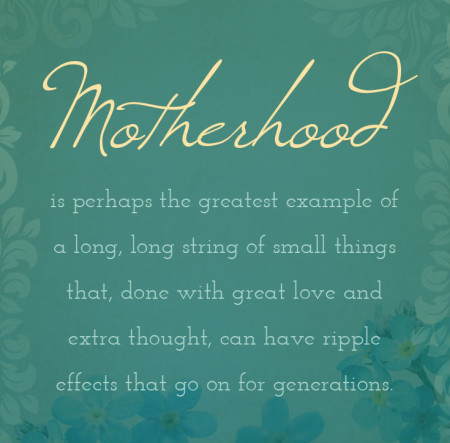 Fortunately, I resisted the impulse to offer this pregnant stranger a string of platitudes that would go in one ear and out the other. But I do wish I’d asked for her name and address, so I could send her instead a copy of this lovely, profoundly inspiring anthology, Motherhood Realized. Although official publication date is still a week away, early readers are discovering in this book an instant community of wise, eloquent, dedicated mothers – the very chorus of voices I would love to have offered my young friend on the plane, to support and guide and accompany her through all the twists and turns of the years ahead.
Fortunately, I resisted the impulse to offer this pregnant stranger a string of platitudes that would go in one ear and out the other. But I do wish I’d asked for her name and address, so I could send her instead a copy of this lovely, profoundly inspiring anthology, Motherhood Realized. Although official publication date is still a week away, early readers are discovering in this book an instant community of wise, eloquent, dedicated mothers – the very chorus of voices I would love to have offered my young friend on the plane, to support and guide and accompany her through all the twists and turns of the years ahead.
“Heading Home with Your Newborn” might ease a new mom through the drama of giving birth and surviving the first few sleepless nights. But Motherhood Realized is a book that will live on bedside tables for years to come — well-thumbed, underlined, bookmarked, shared. Here are the personal stories of mothers just like you and me, not experts who have everything figured out or agendas to promote, but ordinary women who have seized time from their daily lives to report from the trenches of firsthand experience and who have summoned the courage to write from their hearts – the ups, the downs, the hard lessons learned, the small moments savored, the tears shed, the priorities reordered, the humble revelations celebrated, the inevitable challenges confronted.
Gathered from the rich archives of Power of Moms, one of the largest and most beloved online communities of mothers, the pieces selected for inclusion in Motherhood Realized comprise the literary equivalent of an intimate coffee hour with your most engaging, most observant, most empathetic women friends. It’s an honor for me to have one of my own essays (about grown-up children returning home again) included here, and it was a joy to read the other pieces and find myself in such good, varied company. Kindred souls, for sure.
Power of Moms defines itself as a community of “deliberate mothers.” Not perfect mothers, not stay-at-home or working or home-schooling mothers, not mothers of any particular religious or philosophical bent, but rather mothers who have simply made a choice to be thoughtful about, and fully present to, the day-in-day-out demands and joys of family life and child-rearing. If this sounds like you, then you, too, will find sustenance and companionship in these pages.
I’m delighted to offer one copy of this special book to a reader here.
Enter to win a copy of Motherhood Realized.
Just leave a comment below. Answer the question, “What is your greatest parenting challenge or joy right now?” Or, if you prefer, simply say “Count me in.”
One book winner will be chosen at random on Tuesday, April 8, the official publication day.
For more info, visit here.
To order the book, click here.
The post Motherhood Realized appeared first on Katrina Kenison.
February 27, 2014
Otherwise
 Long after most of my friends in their fifties had given up running, I continued. Not every day, and not very far, and not for very long. Better, I thought, to save my knees to run again another day than to push myself to go another mile or another twenty minutes. For the last few years, I’ve run less in the hope of running longer. If I was careful, I figured, I would run right into my sixties.
Long after most of my friends in their fifties had given up running, I continued. Not every day, and not very far, and not for very long. Better, I thought, to save my knees to run again another day than to push myself to go another mile or another twenty minutes. For the last few years, I’ve run less in the hope of running longer. If I was careful, I figured, I would run right into my sixties.
Even so, there wasn’t a morning that I laced up my sneakers and headed down the road with the wind in my hair, fresh air filling my lungs, and my beloved border collie Gracie trotting at my heels, that a line by poet Jane Kenyon didn’t cross my mind: “But one day, I know, it will be otherwise.”
“Otherwise” is Jane Kenyon’s hymn of gratitude to her life just as it was on one blessed, ordinary day — gratitude that is burnished by her own profound awareness of life’s fleetingness, of change, of mortality.
The lines of this heart-breakingly prescient poem always give me pause. Jane Kenyon died of leukemia at forty-seven. Her “otherwise” came tragically soon, a stark reminder – as is every untimely death or freak accident or life-changing diagnosis – that our very existence here is fragile, unpredictable, not to be taken for granted.
And yet, I suspect I’m not alone when I admit that most days it’s a challenge to maintain that perspective. Perhaps it’s human nature to weave ourselves a thin, protective mantle of denial about life’s one and only absolute truth: nothing lasts.
Waking up in the morning, I set my sights on the beginnings of things, not the endings – I run through my to-do list, ponder the essay I want to write, wonder where I’ll find the hour I need to exercise, think about the talk I’ll give next week. Before long, I’m preoccupied with bills to pay, emails to answer, the dishes piled in the sink. The preciousness of life is rarely uppermost in my mind as I deal with what the day hands me; too often, instead, I find myself succumbing to frustration at the way things are: not what I’d planned, not quite up to my expectations, not this, not that.
Fortunately, I’ve always known where to find an instant antidote to my own petty annoyances. No matter how out of sorts I am—with myself, with a family member, with the demands of a difficult day–I need only step outside to reconnect with my more mindful, expansive self. The clouds sailing overhead, a pair of cardinals taking turns at the feeder, a patch of damp earth newly revealed in a sunny corner by the front door, the slow erosion of last week’s snow – noticing these things, I’m restored to my better self, refreshed by wonder: the world is at once beautiful and harsh, living and dying, always in flux — and I’m changing, too, just one small part of the infinitely complex, eternal flow.
Running in all kinds of weather, feeling that inimitable rush of endorphin-induced well-being, has long been my quickest, clearest path both to peace and into the present moment – a moment which, I remind myself with each step, is already in the process of turning into something else. How to respond — other than by giving thanks again and again for my own strong body, for my life as it is, for the simple fact that I’m here, heart pounding and two strong legs carrying me onward as the miles accumulate in my wake.
Over the last several months, I’ve had to confront the first chronic injury of my life. The initial problem, ironically, was the result not of running, but of too many hours spent sitting cross-legged with a lap desk for my computer balanced on my knees.
“A writing injury,” I said at first, laughing it off, certain my pulled groin muscle was nothing a little time and a different position in the chair wouldn’t fix. Unable to run, I settled for power walking instead. I grudgingly gave up jump-backs in yoga and found I had to think carefully before making a lunge forward. Some days, I pushed through the discomfort to do exactly what I wanted to do, groin muscle be damned. Other days, the pain had its way with me and I was forced to stillness.
But instead of healing, the injury deepened and, in a sort of domino effect, led to yet more trouble. By January, I had to lift my left leg with both hands in order to get in and out of the car. Putting on my underpants required slow motion and deep breaths and even so resulted in sharp, shooting pains through my thigh. Stairs were agony. If I dropped something on the floor, I left it there rather than attempt to bend over to pick it up. Yoga, always a joyful release and exploration, became just another challenge to endure, my attempts to modify poses finally resulting in more time spent sitting on my mat than doing asana practice. Lying in bed, with a pillow propping up my knee, my entire left hip and leg throbbed. There was no good position. There have been many nights with no sleep, either.
It’s hard for me to admit what a struggle this has been. Being forced to give up the very activities I’ve long relied on for my peace of mind has been humbling, to say the least. An injured leg is hardly traumatic in the great scheme of things; I have friends and loved ones who are dealing with far more debilitating health issues. Yet as the weeks went by, the combination of discomfort and inactivity and sleeplessness brought me to my knees. Life felt constricted, narrowed down to a monochromatic prism of pain, frustration, exhaustion.
One day last month, after a long week of being cooped up in the house and barely moving, my leg seemed just a bit better. I put on layers of warm clothes against the sub-freezing temperatures, stepped outside and, eager to get some exercise at last, set off down the road at my usual clip – a fast, determined walk.
Two steps, four, six, stop. I hadn’t even reached the mailbox before the spasms in my thigh had me gasping in pain. It was January and twelve degrees. Our beautiful dog had been gone two months and I missed her desperately. My leg refused to do my bidding, instead it pulsed back at me in furious protest. I turned toward the house in defeat, tears freezing on my cheeks.
And then I stopped again. I couldn’t bear to give up and go back inside. But I couldn’t take my walk, either. What to do?
Slowly and with great care, I turned around once more. I took a long deep breath and one very, very small step. “Soften, soften, soften,” I whispered to myself, to my heart, to the poor inflamed muscles in my leg. Instead of contracting the hurt place, I tried relaxing it completely. Instead of moving quickly, I barely moved at all. The pain eased a little, clearing space for another deep breath, another tiny step, a glimmer of understanding. Maybe, just maybe, I was ok right where I was. And maybe, if I released my white-knuckle grip on all I couldn’t have and all I couldn’t do, I could find a different way to move forward.
For weeks, I realized, I’d been angry. Perhaps moving forward really meant moving beyond that impotent, helpless anger and surrendering instead to everything I couldn’t fix or control. I’d been annoyed at my body for letting me down; why not be grateful to it for still holding me up? I’d been disappointed by my failure to cope with grace; why not acknowledge that I’d done the best I could? I’d been secretly disgusted at myself for not being invincible; why not yield at last to my own tender humanness?
I suspect now that the brief, halting, weepy walk I took on that bitter January day was in fact my first true step toward healing. After months of ignoring and resisting the information my injury was offering me, I finally stood in the middle of the road, with no idea which way to turn next, and began to hear what it had to say.
Letting go of my anger meant letting go of the suffering I was bringing upon myself. There was nothing I could do about the pain in my leg, but I could do something about my attitude toward it. Perhaps what I most needed to be cured of was not my over-stretched groin muscle, but my ego — the idea that I am unstoppable.
This, of course, is the central task of growing up and of growing old: learning to ride the ineluctable waves of loss and sorrow as we come face to face with the truth of our own unimportance and our own impermanence. Life has offered me plenty of opportunities to practice of late. Suffice it to say, I don’t have to look far to see things falling apart. But as this winter has taught me, to know loss in the mind isn’t the same as learning it in the body or feeling it in the heart.
There is nothing quite like pain – be it physical or emotional — to shine a bright light on just how vulnerable we really are. We can put up a stoic front, or go down kicking and fighting. Or, if we’re lucky, we may begin to glimpse some small measures of grace and meaning even in the midst of changes we couldn’t have foreseen and circumstances we never would have chosen.
Over the last few weeks, I’ve been deeply moved by a friend’s unwavering presence and empathy. I’ve been thankful for my husband’s steady support and encouragement, for several sessions of deep-tissue bodywork that brought instant relief, for hot showers and Ibuprofen and every hour of uninterrupted sleep. I’ve written more, read more, rested more. I’ve cried more. I’ve watched the snow fall day after day and left the shoveling to others. I’ve found a way to practice yoga that is safe and therapeutic and, in my classes, a way to teach poses that I can’t do myself. I’ve stepped outside at dusk, buckled on my snowshoes, and taken a few gentle expeditions through weightless powder into the silent woods. I’ve chosen gratitude as often as I could. I’ve taken time to appreciate each small good thing.
And, a month later, I’m feeling somewhat better. Softness and acceptance creates a more fertile ground for healing than resentment and resistance. Instead of pushing myself each day, I’m finding that patience is its own kind of progress. I’m trying harder to listen to my body, rather than forcing it to listen to me. No longer adversaries, we’re working together to find a new way forward – not running anymore, but still moving, albeit at a different pace.
Today, for the first time in a long time, I find that I can walk without pain. In Florida visiting my mom for the week, I feel liberated after these long, cold winter months spent mostly inside. It is t-shirt weather here, and everything is green with life. I’m taking it slow, one step at a time, in no hurry to get anywhere. I’m thankful for the breeze on my cheek, the measured rhythm of my steps on the pavement, the sweat needling my back, the ghost of a heart in the sidewalk. The hibiscus are in bloom. Palm fronds click in the breeze. A mockingbird delivers its wildly exuberant medley as I pass beneath its perch. It is a joy to be here, putting one foot carefully in front of the other.
One day, I know, it will be otherwise.
Otherwise
I got out of bed
on two strong legs.
It might have been
otherwise. I ate
cereal, sweet
milk, ripe, flawless
peach. It might
have been otherwise.
I took the dog uphill
to the birch wood.
All morning I did
the work I love.
At noon I lay down
with my mate. It might
have been otherwise.
We ate dinner together
at a table with silver
candlesticks. It might
have been otherwise.
I slept in a bed
in a room with paintings
on the walls, and
planned another day
just like this day.
But one day, I know,
it will be otherwise.
~ Jane Kenyon
The post Otherwise appeared first on Katrina Kenison.
February 18, 2014
Dear Older, about these cars. . .
 “We must always change, renew, rejuvenate ourselves; otherwise we harden.” ~Goethe
“We must always change, renew, rejuvenate ourselves; otherwise we harden.” ~Goethe
This is the second in a series of letters between me and my friend, author Margaret Roach, on the challenges (and joys!) of aging. I’m Old (just 55) and she’s Older (facing 60 this year). And since we’re surely not the only ones buying wrinkle creams, we decided to share our exchange with you, too. Be sure to read Margaret’s letter to me here.
Dear Older,
Oh Margaret! You would have to bring up our cars.
Well, I’m not going to lie about age here. Yes, my Acura is ten years old. And she’s about to roll over 170,000 miles – that’s a lot of trips taken, a great deal of life lived, many bridges crossed.
Buying this car was the first thing Steve and I did in 2003 when we left the suburbs of Boston and moved back to my country roots. If we were going to make our home in a place where the last snow might not melt til mid-April, I wanted a car that would carry me through our Northern winters without too much anxiety on my part. “Good in snow” was my top priority when we went out shopping for new wheels.
It’s worth remembering that gas cost $1.54 a gallon when we arrived in New Hampshire to embark on this new life. “Good mileage” was on my list, but it was somewhere below good visibility, comfort, and safety.
Jack was eleven and Henry was just starting high school when I began driving the kids around rural New Hampshire in my brand new silver MDX. (Family trips we took in our Toyota Sienna minivan – plenty of room for two parents, two boys, one dog and gear for all, and already showing the wear and tear of four years of hard daily use.) The Acura was the nice car. My car. And, I’ll admit: it was and is the only car I’ve ever loved.
A little back story: I’m not a natural behind the wheel. I shudder to recall my first solo forays on our rural roads after I got my driver’s license in 1974. The car: my parents’ 1970 red Plymouth Fury sedan, graciously bequeathed to me. The most notable feature of that car was its size. Huge. I have vague, unsettling memories even now of drifting around curves in the road, wondering if I was going a little too fast, fighting to hold the car on the pavement, straining to sit tall enough in the broad, slippery seat to see out the windshield. To drive that car was to experience the rather surreal sensation of hurtling down the road at the wheel of a small houseboat, guiding it along its way with a white knuckle grip.
The first time I was given permission to take the Plymouth on a trip beyond my well-worn daily routes of school, work, and friends’ houses, it was to drive to Lowell, where my three best friends and and I would park, hop on a train to the Boston Garden and attend a Neil Young concert.
I’d never driven in an unfamiliar neighborhood, or maneuvered down a crowded city street, or negotiated my way through narrow passages between parked cars. By the time I finally docked the mammoth Fury at the train station, I’d clipped off not one but both of my side mirrors, in two separate heart-stopping incidents.
Trying to explain the pair of accidents to my parents the next morning, the best I could offer was: “I’m just never really sure where the car ends and the air begins.”
Skip ahead thirty years. Time and experience and a dedicated yoga practice have given me a better sense of where I am in space. After years of panic attacks at the wheel, avoiding city driving at all costs, and doing everything I can to get out of driving at night, I am actually a pretty confident driver. I have to be. I’m the main chauffeur for two boys with wildly disparate interests.
In sharp contrast to our geographically concentrated urban life, everything in the country is spread out and far apart. Our new schedule requires weekly trips to Boston for piano lessons and treks all over the Southern part of the state for Little League baseball games. The house we’re building is on one side of a mountain, the schools our sons attend on the other – and there are multiple daily crossings, in all kinds of weather. We travel to AAU basketball games and All-State Concerts and field trips and summer camps in Maine. Once a month I return to our old home town for my book group meeting. A dear friend and former neighbor gets sick; I make up an excuse every week to make the three-hour round trip to see her. Jack enrolls in boarding school three hours away, and for three years I make drive after drive, learning the road to the Berkshires by heart.
The miles add up. And my car, my trusty Acura, never lets me down. The car feels like an extension of me. I know exactly where it ends and where space begins. We are in synch, well-matched fellow travelers.
Meanwhile, first one son then the other comes of age and passes the driving test. I take a deep breath and hand over my keys. I sit in the passenger seat one winter morning as my son Henry drives us off the road and straight into a tree, having glanced down for a moment to look for a CD case. (Three months in my mom’s borrowed Subaru while my car’s in the shop only makes me appreciate my sturdy, graceful MDX all the more. It is fixed at last, good as new, ready for the exploits of the next brother.)
I spend many nights staring at the ceiling, waiting for the sound of the garage door opening and closing again, signaling the safe return of an adolescent son. My nose is good: no matter how carefully the car’s been checked by its teenaged occupants or how long the windows have been rolled down to air out telltale scents, I can always piece together a morning-after story. I sniff the air, pick up bits of trash from the floor, check the GPS history. I’m a mother. There are no secrets.
These days, there are no stories, either. No one asks for my keys anymore. Henry, living in New York, makes his way in the world by subway. Jack, in school in Atlanta, is thrilled with his own first car, a Volkswagen Jetta that he wisely kept off the road during this winter’s crazy southern storms. Steve celebrated a brief break in our tuition-paying-cycle last year by treating himself to his own “dream car,” a Chevy Volt that runs 44 miles on a charge, gets 30 miles to the gallon when it switches to gas and boasts a great sound system, plush seats, and sleek styling.
Everyone has moved on, it seems, but me.
I did go out last fall and test drive a few new models: a Ford Escape, a Honda CR-V, a Mazda CX-5. All those gadgets! The fancy dashboards, Bluetooth and audio streaming, and back-up cameras were intimidating. Sure a USB port would be nice — books on tape for the road! — but at the end of the day, all I really wanted to do was climb back into my familiar seat, slip in an Alison Krause CD, and point the reliable old gal toward home.
Instead of a new car, I treated my silver friend to a day in the shop and had all her dings and dents pulled out – the automotive equivalent of Botox, I suppose. She returned to me looking years younger, perky and clean, although of course the odometer reveals the unavoidable truth: try as we might to hold on the illusion of youth, such struggles are in vain.
So yes, we’re in the same boat here, Margaret. To give up our cars is also to acknowledge so much else that’s over. It’s to let go of who we each were ten years ago. (Would we have had time to be such close friends back then? My guess is not.) And it’s to step into futures that feel so much less certain than our rigorously productive, wide-ranging pasts.
The day I trade in my car is the day I’ll also sever an ineffable strand connecting the younger, busier, faster-moving me of ten years ago to the older, less entangled empty nester I am today. Good-bye to the last vestiges of soccer mom, hello to. . .whom??
I’m still not sure. But here’s my thought. We’re both in good shape and life is long. Our cars may be worn out, but we aren’t. I see adventures on the horizon. Road trips, perhaps. Voyages of discovery, with jazzy soundtracks courtesy of our new four-speaker sound systems.
It’s time to get a move on. West Springfield you say? Just as soon as I get plowed out from this latest snowstorm. . .
Love,
Old
P.S. To our readers: Are you attached to your old cars, too? Got any recommendations for us when we go out for those test drives? Margaret is over here, with her aging Saab story; this is my response. And if you missed our first letters, they are here. Of course, we’d love to hear from you, too!
The post Dear Older, about these cars. . . appeared first on Katrina Kenison.



